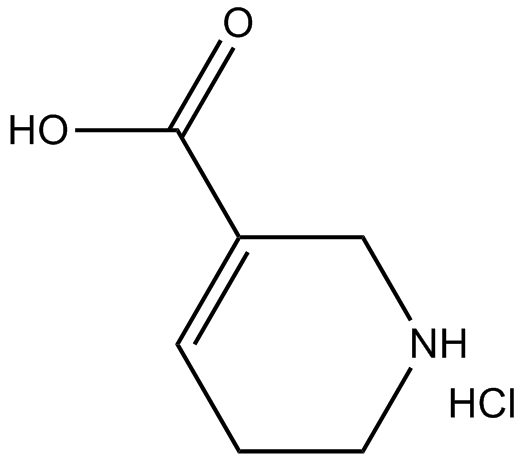Guvacine hydrochloride |
| Catalog No.GC14659 |
GABA uptake inhibitor
Products are for research use only. Not for human use. We do not sell to patients.

Cas No.: 6027-91-4
Sample solution is provided at 25 µL, 10mM.
Guvacine hydrochloride is an alkaloid from the nut of Areca catechu, acts as an inhibitor of GABA transporter, and dispalys modest selectivity for cloned GABA transporters with IC50s of 14 μM (human GAT-1), 39 μM (rat GAT-1), 58 μM (rat GAT-2), 119 μM (human GAT-3), 378 μM (rat GAT-3), and 1870 μM (human BGT-3).
Guvacine hydrochloride is a potent inhibitor of GABA transporter, dispalys modest selectivity forcloned GABA transporters with IC50s of 14 μM (human GAT-1), 39 μM (rat GAT-1), 58 μM (rat GAT-2), 119 μM (human GAT-3), 378 μM (rat GAT-3), and 1870 μM (human BGT-3). Guvacine has low affinity at hBGT-1 (IC50 >1 mM)[1]. Guvacine hydrochloride is a potent inhibitor of GABA uptake, but does not inhibit sodium-independent GABA binding, and is weak or inactive as a GABA receptor agonist[2]. Guvacine inhibits the uptake GABA and β-alanine with IC50s of 23 ± 2 μM, 66 ± 11 μM in the Cat spinal cord, and 8 ± 1 μM, 123 ± 28 μM in the rat cerebral cortex, respectively[3].
References:
[1]. Borden LA, et al. Tiagabine, SK&F 89976-A, CI-966, and NNC-711 are selective for the cloned GABA transporter GAT-1. Eur J Pharmacol. 1994 Oct 14;269(2):219-24.
[2]. Krogsgaard-Larsen P, et al. Structure-activity studies on the inhibition of GABA binding to rat brain membranes by muscimol and related compounds. J Neurochem. 1978 Jun;30(6):1377-82.
[3]. Lodge D, et al. Effects of the Areca nut constituents arecaidine and guvacine on the action of GABA in the cat central nervous system. Brain Res. 1977 Nov 18;136(3):513-22.
Average Rating: 5 (Based on Reviews and 22 reference(s) in Google Scholar.)
GLPBIO products are for RESEARCH USE ONLY. Please make sure your review or question is research based.
Required fields are marked with *




















